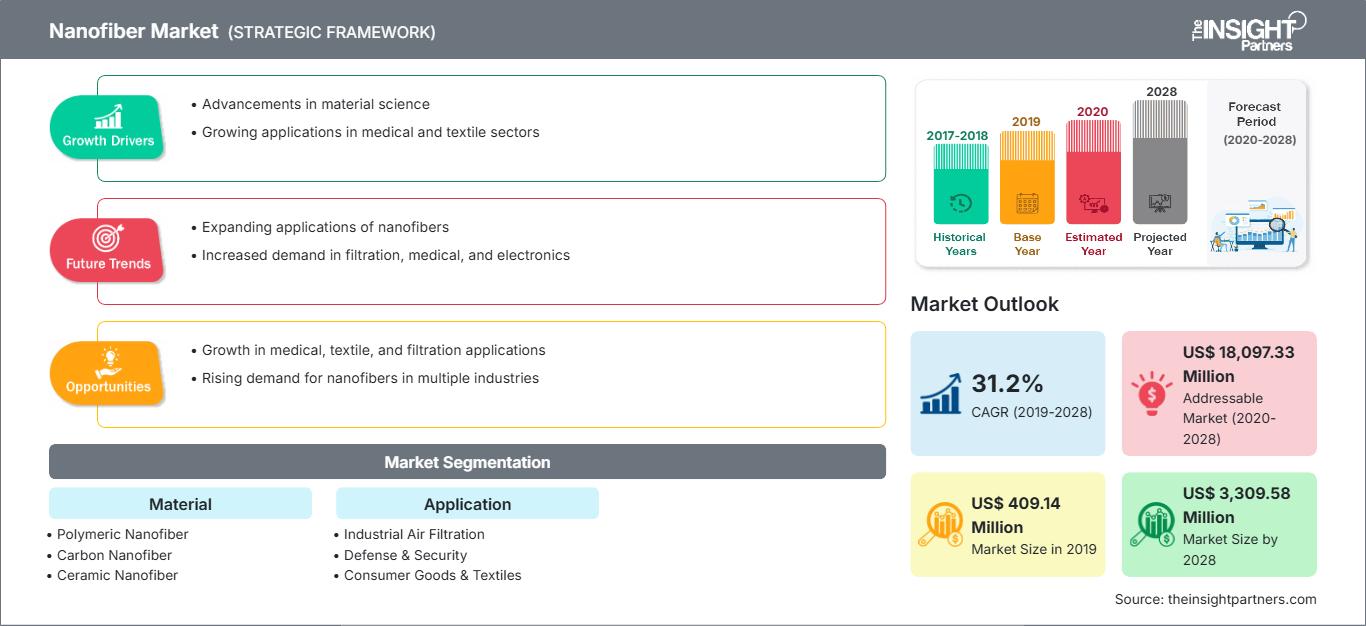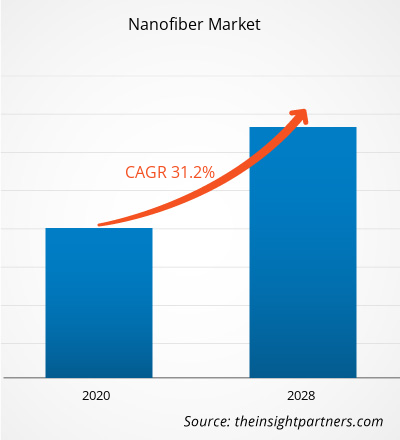2019年,纳米纤维市场规模为4.0914亿美元,预计到2028年将达到33.0958亿美元;预计2020年至2028年的复合年增长率为31.2%。
纳米纤维是指直径小于1微米的纤维。这些纤维有助于提高过滤效率,同时渗透性略有下降。快速的工业化进程、纳米纤维产品的商业化进程以及工业应用的不断增加、持续的技术创新以及研发投入的增加,都是推动纳米纤维市场增长的重要因素。
2019年,亚太地区是最大的纳米纤维市场。亚太地区汇聚了许多发展中国家,这些国家的制造业正在高速增长;该地区已成为全球制造业中心。随着中国逐渐发展成为高技能制造业中心,印度、韩国、台湾和越南等其他发展中国家也吸引了众多企业,这些企业正寻求将其中低技能制造设施迁往劳动力成本更低的邻国。这些国家的政府也通过改善投资理念或鼓励外商直接投资 (FDI) 来欢迎此类企业。由于各国政府实施的封锁、旅行禁令和企业停业,新冠疫情 (COVID-19) 对各国的经济和行业造成了不利影响。化工和材料行业是遭受严重影响的主要行业之一,其供应链中断、技术活动取消以及办公室关闭等问题频发。北美、欧洲、亚太地区、南美以及中东和非洲地区的多家工厂停工,限制了全球供应链,扰乱了制造活动、交付计划和产品销售。此外,多家公司已经预测其产品未来交付可能会延迟,销量也可能出现下滑。欧洲、亚洲和北美各国实施的旅行禁令正在阻碍商业合作和伙伴关系机会。此外,由于社交隔离措施导致专业人员数量有限和生产水平下降,这些因素也阻碍了化学和材料行业以及相关市场的正常运作。许多国家正在逐步恢复正常,但也有许多国家正在经历第二波疫情。此外,由于疫苗接种运动的开展,未来几个月的情况可能会有所改变。
自定义此报告以满足您的要求
您将免费获得任何报告的定制,包括本报告的部分内容,或国家级分析、Excel 数据包,以及为初创企业和大学提供超值优惠和折扣
纳米纤维市场: 战略洞察

-
获取本报告的主要市场趋势。这个免费样本将包括数据分析,从市场趋势到估计和预测。
市场洞察
工业化进程快速发展,亟需减少工业工厂的有害排放
随着越来越多的新兴地区投资于本地制造工厂,全球制造业正在迅速扩张。根据中国物流与采购联合会 (CFLP) 的数据,2017 年 10 月全球制造业采购经理指数 (PMI) 为 55.1,2017 年 9 月为 55.9;然而,该指数在这几个月总体处于高位。自 2017 年初以来,PMI 指数一直保持在 53.5 左右,这表明发达国家制造业强劲复苏,新兴经济体工业进步不断加快,全球市场大宗商品价格不断上涨。蓬勃发展的制造业预计将采用技术进步来获得竞争优势,方法是提高工厂生产力并及时了解客户偏好的变化。制造业目前正处于技术复兴时期,这正在改变现代工厂的面貌和流程。然而,各行各业运营规模的扩大也加剧了环境危害,尤其是在重工业化城市。重工业化还通过有毒排放影响着这些企业周边居民的健康。
材料洞察
纳米纤维市场根据材料细分为聚合物纳米纤维、碳纳米纤维、陶瓷纳米纤维、玻璃纳米纤维等。碳纳米纤维领域在2020年占据了纳米纤维市场的最大份额。碳纳米纤维是通过在极高温度下从合成聚合物和生物聚合物中去除非碳元素而制成的。在碳纳米纤维制造的浮动催化剂法中,粉末或载体形式的各种金属被用作催化实体。箔、纱布和线等是用于生产纳米纤维的其他催化剂。碳纳米纤维表现出高不连续性和兼容性等物理特性,并且还具有高度的石墨性。它们具有优异的机械性能以及高导电性和导热性。碳纳米纤维的应用领域包括热塑性塑料、弹性体、热固性材料、陶瓷、弹性体和金属。此外,由于其高拉伸强度以及导热性和导电性,碳纳米纤维还广泛用于骨科、牙科和组织工程支架。
应用洞察
根据应用,纳米纤维市场细分为工业空气过滤、国防和安全、消费品和纺织品、电子元件、电力和能源、医疗保健和生命科学、化学和环境等。医疗保健和2020 年,生命科学领域占据最大市场份额,引领市场。纳米纤维中使用的可生物降解材料最适合医疗保健行业。此外,添加剂的加入使这些纳米纤维具有多种功能。由于纳米纤维的结构和尺寸可以控制,因此可以用于组织工程。纳米纤维在生命科学和制药行业的主要应用包括药物输送、伤口愈合、组织工程和阻隔纺织品。
纳米纤维市场的主要参与者包括 Ahlstrom-Munksjo、旭化成株式会社、唐纳森公司、杜邦公司、Nanofibers Solution LLC, Inc.、东丽株式会社、Espin Technologies、Elmarco SRO、Mempro Ltd. 和 Revolution Fibers Ltd.。市场上的主要公司专注于并购和产品发布等战略,以扩大其地域影响力和消费者基础。例如,2018 年,唐纳森推出了创新系统,使燃气轮机过滤器的选择更容易,以便操作员选择替换的空气过滤器,并开发了实验室测试来量化脉冲恢复率和水密性。
报告重点
- 全球纳米纤维市场的渐进式行业趋势,帮助参与者制定有效的长期战略
- 在发达市场和发展中市场运营的公司采用的业务增长战略
- 2017 年至 2028 年全球纳米纤维市场的定量分析
- 对各行业对纳米纤维的需求进行估计
- PEST 分析,以说明行业中的买家和供应商预测市场增长的有效性
- 了解竞争激烈的市场状况和纳米纤维需求的最新发展
- 市场趋势和前景,以及推动和抑制纳米纤维市场增长的因素
- 支撑全球纳米纤维市场增长商业利益的启发性战略,以促进决策过程
- 纳米纤维市场在各个市场节点的规模
- 纳米纤维市场的详细概述和细分,以及行业动态
- 纳米纤维在各个地区的市场规模以及良好的增长机会
纳米纤维市场区域洞察
The Insight Partners 的分析师已详尽阐述了预测期内影响纳米纤维市场的区域趋势和因素。本节还讨论了北美、欧洲、亚太地区、中东和非洲以及南美和中美洲的纳米纤维市场细分和地域分布。
纳米纤维市场报告范围
| 报告属性 | 细节 |
|---|---|
| 市场规模 2019 | US$ 409.14 Million |
| 市场规模 2028 | US$ 3,309.58 Million |
| 全球复合年增长率 (2019 - 2028) | 31.2% |
| 历史数据 | 2017-2018 |
| 预测期 | 2020-2028 |
| 涵盖的领域 |
By 材料
|
| 覆盖地区和国家 |
北美
|
| 市场领导者和主要公司简介 |
|
纳米纤维市场参与者密度:了解其对业务动态的影响
纳米纤维市场正在快速增长,这得益于终端用户需求的不断增长,而这些需求的驱动因素包括消费者偏好的不断变化、技术进步以及对产品优势的认知度不断提高。随着需求的增长,企业正在扩展产品线,不断创新以满足消费者需求,并抓住新兴趋势,从而进一步推动市场增长。

- 获取 纳米纤维市场 主要参与者概述
- 纳米纤维市场,按材料
- 聚合物纳米纤维
- 碳纳米纤维
- 陶瓷纳米纤维
- 玻璃纳米纤维
- 其他
纳米纤维市场 — 按应用
- 工业空气过滤
- 消费品与纺织品
- 电子元件
- 国防与安全
- 电力与能源
- 医疗保健与生命科学
- 化学品与环境
- 其他
公司简介
- Ahlstrom-Munksjo
- 旭化成株式会社
- 唐纳森公司
- 杜邦公司
- Nanofibers Solution LLC, Inc.
- 东丽株式会社
- Espin Technologie
- Elmarco SRO
- Mempro Ltd.
- Revolution Fibers Ltd.
- 历史分析(2 年)、基准年、预测(7 年)及复合年增长率
- PEST和SWOT分析
- 市场规模、价值/数量 - 全球、区域、国家
- 行业和竞争格局
- Excel 数据集
近期报告
相关报告
客户评价
购买理由
- 明智的决策
- 了解市场动态
- 竞争分析
- 客户洞察
- 市场预测
- 风险规避
- 战略规划
- 投资论证
- 识别新兴市场
- 优化营销策略
- 提升运营效率
- 顺应监管趋势






















 获取免费样品 - 纳米纤维市场
获取免费样品 - 纳米纤维市场